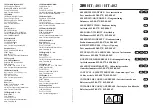
Version
Document Title
Release Date
02
Narrow Body EL2.1 (REV. A)
–
Owner's Manual
2021-03-22
EL 2.1 -
Owner’s
Manual - Rev.02
–
Mar 2021
19
Purge Connection Guide
Following the steps outlined in the gas connection instructions above, connect the H
2
purge port,
located at the bottom left of the front panel, to your hydrogen purge outlet.
During ramp-up, after ramp down and also periodically during operation, the EL2.1 depressurises and
releases up to 20 litres of hydrogen within 2 seconds. The result is a momentary flow rate of around
10
NL/s which comes out of the H
2
Purge outlet. Additionally, with each major purge of the device,
between 1-10 ml of water (mostly liquid) is released with the gas.
Attention!
It is not the responsibility of Enapter S.r.l. to install and ensure the purge line
is appropriately managed and maintained.
Carefully refer to local rules and
regulations, apply industrial safety standards where possible and assess the
risks associated with the operation of the device!
Attention!
Do not insert any check valves or obstructions into the purge line.
This can
cause irreparable damage to your hydrogen system.
Please contact the Enapter support team for questions regarding the purge
line setup.
The released hydrogen will pose a risk of explosion
–
therefore, it has to be led into a safe area, which
is defined by the absence of any source of ignition. We recommend to lead the purge output to a safe
area, described in the section "
Safety areas around the purge and vent outlet
" below, and to elevate
the purge outlet to at least 3m above the Electrolyser. If this is not possible, you may also manage the
purge in other ways, such as using a flare stack, burn box or forced dilution.
Warning!
The gaseous outputs from the oxygen vent and the hydrogen purge must be
kept separated. Mixing of these outputs results in an explosive atmosphere.
Warning!
Follow local directives rules and regulations for the safe dispersion of the
purged gas. Ensure a satisfactory safety concept is in place and is being
utilised to manage the hydrogen purge.
It is the installer's/user's or owner's responsibility to
regularly check and
maintain the purge line
, as well as to keep the line free of ice or obstructions.
















































